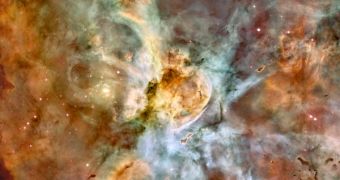The Carina Nebula (NGC 3372) is one of the largest and brightest such formations in the sky, and also one of the most complex and intricate, as far as internal structures go. The 100 light-years-long formation is approximately 4 times larger than the Orion nebula, and is located in the Constellation bearing the same name, some 7500 light-years away from our solar system. Inside Carina, numerous clusters give birth to many new blue stars, in an intense stellar-forming process, which is catalyzed by enormous amounts of gases and dust. Thanks to new images released by the European Southern Observatory (ESO), astronomers now have a way of looking deep into its internal structure.
Red and purple dominate the glow of this nebula, giving it its shining aspect, as well as its intense brightness. Astrophysicists hypothesize that these colors are generated by intense interactions between the UV light emanating from huge new stars and hot hydrogen that is plentiful in the region. Despite the fact that the nebula contains more than 12 massive stars, roughly 10 to 100 times the mass of our own Sun, it has to generate them continuously, because such large celestial bodies only have a lifespan of about a few million years, way less than the Sun, which is expected to live over 10 billion years.
The new images, which have helped scientists get a better view of what's going on inside this formation, have been shot by ESO's La Silla Observatory in Chile, more specifically by the 2.2 m ESO/MPG telescope, which has superimposed images from six filters in order to compile the new data. The results have revealed that Eta Carinae, a star found in the nebula, is one of the most impressive in the entire known Universe, which is no little thing. It does have its drawbacks, however, in that, even though it's four million times brighter than the Sun, it's prone to violent outbursts of energy.
It is believed that another star orbits around Eta Carinae, one that also has the ability to generate very powerful solar winds. When the two forces collide, they give birth to interesting phenomena, which have over the years been tracked by many of ESO's instruments throughout the world. Last month, the companion star was the closest to its impressive neighbor, and many observers are still deciphering the data recorded during that time.

 14 DAY TRIAL //
14 DAY TRIAL //